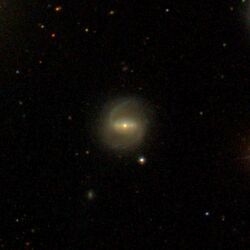Astronomy:NGC 4333
From HandWiki
Short description: Barred spiral galaxy in the constellation Virgo
| NGC 4333 | |
|---|---|
 SDSS image of NGC 4333. | |
| Observation data (J2000 epoch) | |
| Constellation | Virgo |
| Right ascension | 12h 23m 22.3s[1] |
| Declination | 06° 02′ 27″[1] |
| Redshift | 0.023406[1] |
| Helio radial velocity | 7017 km/s[1] |
| Distance | 330 Mly (100 Mpc)[1] |
| Apparent magnitude (V) | 14.48[1] |
| Characteristics | |
| Type | SB(s)ab[1] |
| Size | ~110,800 ly (33.96 kpc) (estimated)[1] |
| Apparent size (V) | 0.9 x 0.7[1] |
| Other designations | |
| VCC 0637, PGC 040217, MCG +01-32-034, CGCG 042-065[1] | |
NGC 4333 is a barred spiral galaxy with a ring structure[2] located about 330 million light-years away[3] in the constellation Virgo. It was discovered by astronomer William Herschel on April 13, 1784,[4] who described it as "F, pS, R, bM, 2nd of 3".[5] NGC 4333 is also classified as a LINER galaxy.[6] Despite being listed in the Virgo Cluster catalog as VCC 637, it is not a member of the Virgo Cluster but instead a background galaxy.[7]
Nearby galaxies
NGC 4333 forms a pair with the galaxy NGC 4326, known as [T2015] nest 102514,[8][9] in which NGC 4326 is the birghtest member of the pair.[9] Both galaxies are part of the CfA2 Great Wall.[10]
See also
External links
- NGC 4333 on WikiSky: DSS2, SDSS, GALEX, IRAS, Hydrogen α, X-Ray, Astrophoto, Sky Map, Articles and images
References
- ↑ 1.0 1.1 1.2 1.3 1.4 1.5 1.6 1.7 1.8 1.9 "NASA/IPAC Extragalactic Database". Results for NGC 4333. http://nedwww.ipac.caltech.edu/. Retrieved 2022-03-02.
- ↑ "HyperLeda -object description". http://leda.univ-lyon1.fr/ledacat.cgi?o=ngc%204333.
- ↑ "Your NED Search Results". https://ned.ipac.caltech.edu/cgi-bin/objsearch?objname=NGC+4333&extend=no&hconst=73&omegam=0.27&omegav=0.73&corr_z=1&out_csys=Equatorial&out_equinox=J2000.0&obj_sort=RA+or+Longitude&of=pre_text&zv_breaker=30000.0&list_limit=5&img_stamp=YES.
- ↑ "New General Catalog Objects: NGC 4300 - 4349". https://cseligman.com/text/atlas/ngc43.htm#4333.
- ↑ "NGC/IC Project Restoration Efforts". https://ngcicproject.observers.org/NGC/NGC_43xx/NGC_4333.htm.
- ↑ Toba, Y.; Oyabu, S.; Matsuhara, H.; Malkan, M. A.; Gandhi, P.; Nakagawa, T.; Isobe, N.; Shirahata, M. et al. (2014-05-20). "Luminosity and Redshift Dependence of the Covering Factor of Active Galactic Nuclei Viewed Withwiseand Sloan Digital Sky Survey". The Astrophysical Journal 788 (1): 45. doi:10.1088/0004-637X/788/1/45. ISSN 0004-637X. Bibcode: 2014ApJ...788...45T. https://iopscience.iop.org/article/10.1088/0004-637X/788/1/45.
- ↑ Binggeli, B.; Sandage, A.; Tammann, G. A. (September 1985). "Studies of the Virgo Cluster. II - A catalog of 2096 galaxies in the Virgo Cluster area. V - Luminosity functions of Virgo Cluster galaxies". The Astronomical Journal 90: 1681. doi:10.1086/113874. Bibcode: 1985AJ.....90.1681B. http://adsabs.harvard.edu/cgi-bin/bib_query?1985AJ.....90.1681B.
- ↑ "[T2015 nest 10214"]. http://simbad.u-strasbg.fr/simbad/sim-id.
- ↑ 9.0 9.1 Tully, R. Brent (2015-05-01). "Galaxy Groups: A 2MASS Catalog". The Astronomical Journal 149 (5): 171. doi:10.1088/0004-6256/149/5/171. ISSN 0004-6256. Bibcode: 2015AJ....149..171T. https://ui.adsabs.harvard.edu/abs/2015AJ....149..171T.
- ↑ Hoffman, G. Lyle; Lewis, B. M.; Salpeter, E. E. (1995-03-01). "The Large-Scale Distribution of Late-Type Galaxies between Virgo and the Great Wall". The Astrophysical Journal 441: 28. doi:10.1086/175333. ISSN 0004-637X. Bibcode: 1995ApJ...441...28H. https://ui.adsabs.harvard.edu/abs/1995ApJ...441...28H.
 |

